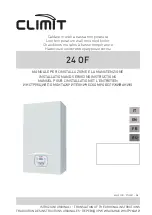
13
water should be no greater than 20 °C. The boiler should not be
started or run with water volumes lower than those indicated in
the following table.
Type of
boiler
Output
∆
t = 15 K (*)
∆
t = 20 K (*)
kCal/h
kW
Water
flow
rate
Water
resist-
ance
Water
flow
rate
Water
resist-
ance
m
3
/h
mbar
m
3
/h
mbar
RTT 76
65,000
75.6
4.333
17.2
3.250
7.6
RTT 93
80,000
93.0
5.333
18.0
4.000
10.0
RTT 110
95,000
110.5
6.333
23.5
4.750
15.6
RTT 128 110,000
127.9
7.333
29.0
5.500
19.0
RTT 145 125,000 145.3
8.333
34.0
6.250
22.3
(*)
∆
t = temperature difference
NOTA:
The RTT boiler has been designed only for heating systems
with forced circulation of hot water.
1.16
Gas side resistance and output temperature
of combustion gases
0,20
20
30
40
50
60
70
80
90
100
110
120
130
140
150
160
0,80
1,40
1,80
2,20
2,60
3,00
Full load
Part Load
Heat output (kW)
Gas side resistance (mbar
)
100
130
180
200
220
160
10
20
30
40
50
60
70
80
90
100
Exit flue gas temperature (°C)
Load (%)
1.17
User instructions
Heating system
In the heating system, the difference between the direct supply
temperature and the water return temperature should not ex-
ceed 20°C. The temperature of the return water should higher
than 50°C. Use the boiler's protection pump to raise the tem-
perature of the return line water. Regularly measure the system's
water level and add water if it is too low. Before adding water to
the system, stop the system and wait for the water temperature
to reach 40°. Check for and resolve any problems due to leaks in
the boiler or in the system.
The hydraulic system should be carried out by qualified person-
nel to meet European standards.
For the system use material complying with European stand-
ards.
Connections to the electrical system and fuel delivery system
All the electrical connections should be carried out in compli-
ance with European standards, using only material approved by
European regulations, by qualified professionals. For the burn-
er, the control panel, Ecopanel etc., read the instructions and
warnings carefully in the instruction manuals supplied by the
manufacturer or distributors. Do not switch on the burner un-
til the circulation has started inside the boiler. If the circulation
pump or the protection pump are faulty, switch off the burner.
The system should work in a coordinated manner.
The circulation pump should always be operating when the
burner is running. Choose a protection pump that is adequate
for the boiler output. Connect the pump to the collectors, to the
valve and to the thermostat correctly. In this way the system
can switch off once the pre-set temperature has been reached.
When faced with any fault (contactor, temperature swings,
interruption of current, other faults), or when the pumps are
stopped (protection pumps, etc.) the burner should switch itself
off. The system should do this automatically.
Carry out the electrical wiring taking into account all the
above-mentioned information.
1.18
Conveyance and discharge of the boiler
water
Discharge of the boiler water
9
Switch off the boiler before emptying the boiler and let it
cool.
To empty the boiler, open all the valves of the circuit and the
radiators. All the system water should be discharged by drain-
ing the boiler, when the latter is in the lower part of the system
itself. If a part of the heating system is below the boiler room,
the process for draining the water can be carried out at a point
situated in the lower part of the system.
Supplying the boiler with water
To fill the boiler with water use the tap upstream of the boil-
er, during the boiler charging operations all the valves of the
hydraulic piping and radiators should be open. To prevent air
infiltration, carry out this operation slowly opening the plug at
the top. When water comes out of this plug it means the process
has finished. Bleed the air from all the radiators.
9
Do not fill the boiler with water when the boiler is hot. This
could damage the elements
9
The quality of the water should correspond to that indicated
in "1.9 Hydraulic system" a pagina 10
1.19
Instructions for disposing of the product
Cast iron boilers have a long life due to the particular character-
istics of the construction materials used. The service life of these
appliances, which is declared in the accompanying legal doc-






































